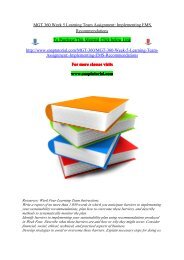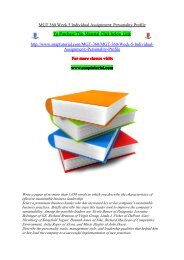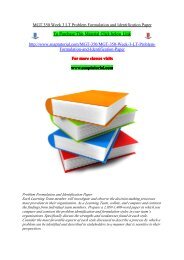MGT 350 Final Exam Guide 1/snaptutorial
For more classes visits www.snaptutorial.com 1) Critical thinking may be stored for use in future decision making. Examples of mechanisms used to “store” critical thinking for future programmed decisions include A. a regression analysis B. a Stakeholder Analysis C. a Pareto Chart D. pre-opening checklist E. a SWOT Analysis 3) When facing a critical decision, a manager should use critical thinking in order to ______ uncertainty A. eliminate B. increase C. reduce D. randomize 4) Kathy is a manager deciding between two applicants for a position reporting to her. One applicant for the position is a close personal friend of Kathy’s. Because Kathy is concerned that self serving bias may influence her to incorrectly see her friend as the best candidate, she should A. allow someone else to make the decision. B. eliminate her bias by not allowing her friend to apply C. ignore her bias and be strictly objective D. any of the above would be an equally valid choice from a critical thinking perspective E. seek input from others before making the decision. 5) Jane has a term paper due, a sick child who needs her attention, and a major project due at work. To save time, she decides to submit a paper for school that is less than her best, but will earn a passing grade. The best description of Jane’s approach is A. creativity B. analyzing C. satisficing D. optimizing 6) Despite all the measures followed, successful decisions are not always guaranteed so it is important to A. develop contingency plans B. only allow the most senior leaders to influence decisions C. use logical thinking to guarantee a correct outcome D. accept that some decisions will not work and move on to other issues E. develop appropriate measurements for the impacts of decisions 7) One way for a leader to develop alternative perspectives for decision making is to A. increase the use of the logical thinking style
For more classes visits
www.snaptutorial.com
1) Critical thinking may be stored for use in future decision making. Examples of mechanisms used to “store” critical thinking for future programmed decisions include
A. a regression analysis
B. a Stakeholder Analysis
C. a Pareto Chart
D. pre-opening checklist
E. a SWOT Analysis
3) When facing a critical decision, a manager should use critical thinking in order to ______ uncertainty
A. eliminate
B. increase
C. reduce
D. randomize
4) Kathy is a manager deciding between two applicants for a position reporting to her. One applicant for the position is a close personal friend of Kathy’s. Because Kathy is concerned that self serving bias may influence her to incorrectly see her friend as the best candidate, she should
A. allow someone else to make the decision.
B. eliminate her bias by not allowing her friend to apply
C. ignore her bias and be strictly objective
D. any of the above would be an equally valid choice from a critical thinking perspective
E. seek input from others before making the decision.
5) Jane has a term paper due, a sick child who needs her attention, and a major project due at work. To save time, she decides to submit a paper for school that is less than her best, but will earn a passing grade. The best description of Jane’s approach is
A. creativity
B. analyzing
C. satisficing
D. optimizing
6) Despite all the measures followed, successful decisions are not always guaranteed so it is important to
A. develop contingency plans
B. only allow the most senior leaders to influence decisions
C. use logical thinking to guarantee a correct outcome
D. accept that some decisions will not work and move on to other issues
E. develop appropriate measurements for the impacts of decisions
7) One way for a leader to develop alternative perspectives for decision making is to
A. increase the use of the logical thinking style
- No tags were found...
Create successful ePaper yourself
Turn your PDF publications into a flip-book with our unique Google optimized e-Paper software.
15) A form of critical thinking is fair-minded persuasive thinking. When engaging in problem<br />
formulation and identification with a group, the fair minded persuader would<br />
16) While this decision style offers an opportunity for stakeholder input, it most lessens<br />
accountability for decision making.<br />
A. Democratic<br />
B. Consensus<br />
C. Autocratic<br />
D. Collaborative/participative<br />
E. Leader decides<br />
17) An appropriate profit relative to funds invested would be a primary consideration of this<br />
stakeholder group.<br />
18) Problems may become apparent to stakeholders through the use of tools which compare<br />
actual results to expected results. An example of such a tool is a<br />
he store’s commission structure for sales personnel. She has decided to exclude the sales<br />
personnel affected from the decision making process. Jan is probably seeking to minimize this<br />
force of influence on the decision making process.<br />
20) Identifying programmed decision opportunities—problems with objectively correct<br />
answers, solvable through the use of simple rules, policies, or numerical computations—<br />
promises this benefit in terms of decision making.<br />
21) Identifying programmed decision opportunities—problems with objectively correct<br />
answers, solvable through the use of simple rules, policies, or numerical computations—<br />
promises this benefit in terms of decision making.<br />
22) For urgent decisions, this approach may be the most efficient and effective use of the<br />
manager’s time when there are other critical competing priorities.<br />
A. Experimenting<br />
B. Optimizing<br />
C. Satisficing<br />
D. Brainstorming and multi-voting with a team<br />
E. Creation of a task force<br />
23) A decision tool that can be helpful in identifying risks to contemplated decisions is<br />
A. a Force Field Analysis<br />
B. a histogram<br />
C. a Pareto chart<br />
D. a periodic table<br />
E. a Fishbone diagram

















